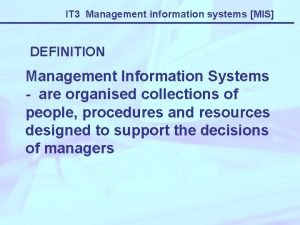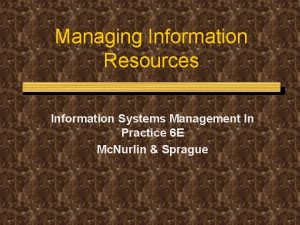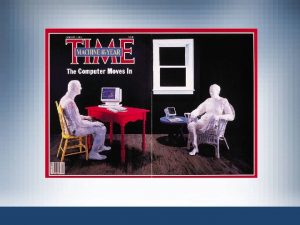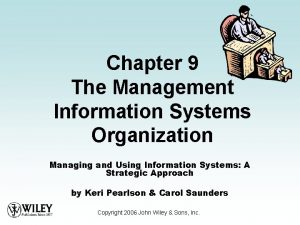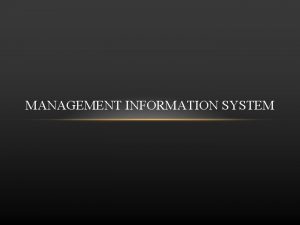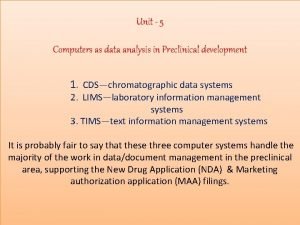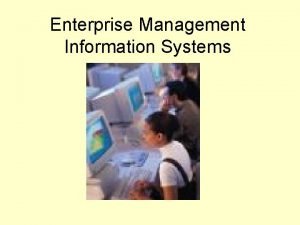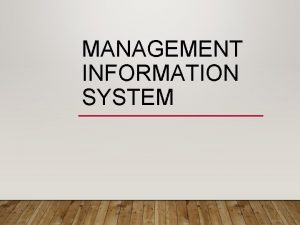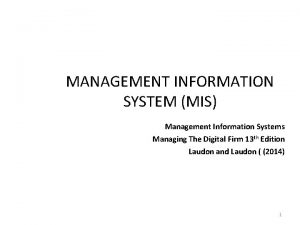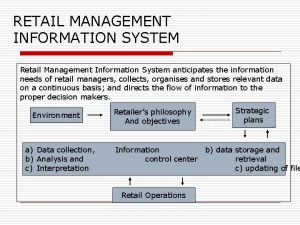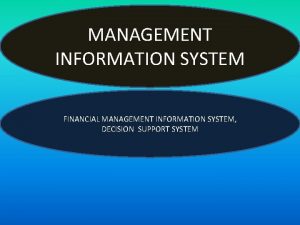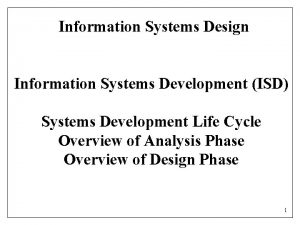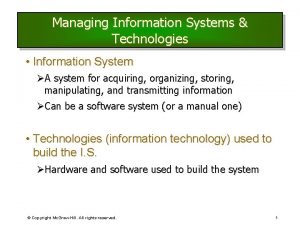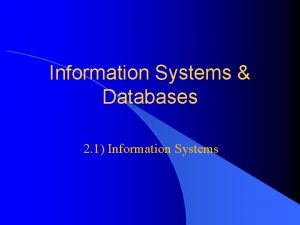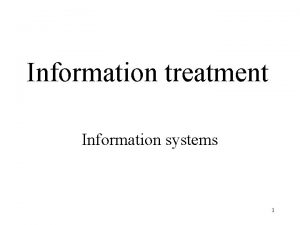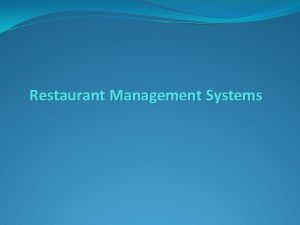MANAGEMENT INFORMATION SYSTEM WHAT IS MANAGEMENT INFORMATION SYSTEMS

















- Slides: 17

MANAGEMENT INFORMATION SYSTEM

WHAT IS MANAGEMENT INFORMATION SYSTEMS (MIS)? • A management information system (MIS) is a computer system consisting of hardware and software that serves as the backbone of an organization’s operations. • An MIS gathers data from multiple online systems, analyzes the information, and reports data to aid in management decision-making. • MIS is also the study of how such systems work.

IMPROVED DECISION-MAKING • The purpose of an MIS is improved decision-making, by providing up-to-date, accurate data on a variety of organizational assets, including: § § § § § Financials Inventory Personnel Project timelines Manufacturing Real estate Marketing Raw materials R&D

• The MIS collects the data, stores it, and makes it accessible to managers who want to analyze the data by running reports.

CENTRAL INFORMATION SYSTEM • The goal of an MIS is to be able to correlate multiple data points in order to manage ways to improve operations. • For example, being able to compare sales this month to sales a year ago by looking at staffing levels may point to ways to boost revenue. Or being able to compare marketing expenditures by geographic location and link them to sales can also improve decision-making. But the only way this level of analysis is possible is due to data that is compiled through an MIS. • Running reports that pull together dissimilar data points is an MIS’ key contribution. • MIS implementation is an expensive investment that includes the hardware and software purchases, as well as the integration with existing systems and training of all employees.

MANAGEMENT INFORMATION SYSTEM MANAGERS • The role of the MIS manager is to focus on the organization's information and technology systems. • The MIS manager typically analyzes the business problems and then designs and maintains computer applications to solve the organization's problems. • Within companies and large organizations, the department responsible for computer systems is sometimes called the MIS department. • Other names for MIS include information systems (IS) and information technology (IT).

TYPES OF MIS Management information system is a broad term that incorporates many specialized systems. The major types of systems include the following: • Executive Information System (EIS) • Marketing Information System (Mk. IS) • Business Intelligence System (BIS) • Customer Relationship Management System (CRM) • Sales Force Automation System (SFA) • Transaction Processing System (TPS) • Knowledge Management System (KMS) • Financial Accounting System (FAS) • Human Resource Management System (HRMS) • Supply Chain Management System (SCM)

MIS IN ORGANIZATIONS • A typical organization is divided into operational, middle, and upper level. • The information requirements for users at each level differ. • There are number of information systems that support each level in an organization.

OPERATIONAL MANAGEMENT • Concerned with performing day to day business transactions of the organization. • Examples of users at this level of management include cashiers at a point of sale, bank tellers, nurses in a hospital, customer care staff, etc. • Users at this level use make structured decisions. This means that they have defined rules that guides them while making decisions. • For example, if a store sells items on credit and they have a credit policy that has some set limit on the borrowing. All the sales person needs to decide whether to give credit to a customer or not is based on the current credit information from the system.

TACTICAL MANAGEMENT • Dominated by middle-level managers, heads of departments, supervisors, etc. • The users at this level usually oversee the activities of the users at the operational management level. • Tactical users make semi-structured decisions, based on set guidelines and judgmental calls. • As an example, a tactical manager can check the credit limit and payments history of a customer and decide to make an exception to raise the credit limit for a particular customer. The decision is partly structured in the sense that the tactical manager has to use existing information to identify a payments history that benefits the

STRATEGIC MANAGEMENT • Most senior level in an organization. • The users at this level make unstructured decisions. • Senior level managers are concerned with the long-term planning of the organization. • They use information from tactical managers and external data to guide them when making unstructured decisions.

TRANSACTION PROCESSING SYSTEM (TPS) • Used to record day to day business transactions of the organization. At operational management level. • The main objective of a transaction processing system is to answer routine questions such as; • How many printers were sold today? • How much inventory do we have at hand? • What is the outstanding due for John Doe? • By recording the day to day business transactions, TPS system provides answers to the above questions in a timely manner. • The decisions made by operational managers are routine and highly structured. • The information produced from the transaction processing system is very detailed.

TRANSACTION PROCESSING SYSTEM (TPS) • For example, banks that give out loans require that the company that a person works for should have a memorandum of understanding (Mo. U) with the bank. If a person whose employer has a Mo. U with the bank applies for a loan, all that the operational staff has to do is verify the submitted documents. If they meet the requirements, then the loan application documents are processed. If they do not meet the requirements, then the client is advised to see tactical management staff to see the possibility of signing a Mo. U. • Examples of transaction processing systems include; • Point of Sale Systems – records daily sales • Payroll systems – processing employees salary, loans management, etc. • Stock Control systems – keeping track of inventory levels • Airline booking systems – flights booking management

MANAGEMENT INFORMATION SYSTEM (MIS) • Used by tactical managers to monitor the organization's current performance status. • The output from a transaction processing system is used as input to a management information system. • The MIS system analyzes the input with routine algorithms i. e. aggregate, compare and summarizes the results to produced reports that tactical managers use to monitor, control and predict future performance. • For example, input from a point of sale system can be used to analyze trends of products that are performing well and those that are not performing well. This information can be used to make future inventory orders i. e. increasing orders for well-performing products and reduce the orders of products that are not performing well.

MANAGEMENT INFORMATION SYSTEM (MIS) • Examples of management information systems include; • Sales management systems – they get input from the point of sale system • Budgeting systems – gives an overview of how much money is spent within the organization for the short and long terms. • Human resource management system – overall welfare of the employees, staff turnover, etc. • Tactical managers are responsible for the semi-structured decision. • MIS systems provide the information needed to make the structured decision and based on the experience of the tactical managers, they make judgement calls i. e. predict how much of goods or inventory should be ordered for the second quarter based on the sales of the first quarter.

DECISION SUPPORT SYSTEM (DSS) • Used by senior management to make non-routine decisions. • DSS use input from internal systems (transaction processing systems and management information systems) and external systems. • The main objective of DSS is to provide solutions to problems that are unique and change frequently. It answers questions such as; • What would be the impact of employees' performance if we double the production lot at the factory? • What would happen to our sales if a new competitor entered the market? • Decision support systems use sophisticated mathematical models, and statistical techniques (probability, predictive modeling, etc. ) to provide solutions, and they are very interactive.

DECISION SUPPORT SYSTEM (DSS) • Examples of decision support systems include; • Financial planning systems – it enables managers to evaluate alternative ways of achieving goals. The objective is to find the optimal way of achieving the goal. For example, the net profit for a business is calculated using the formula Total Sales less (Cost of Goods + Expenses). A financial planning system will enable senior executives to ask what if questions and adjust the values for total sales, the cost of goods, etc. to see the effect of the decision and on the net profit and find the most optimal way. • Bank loan management systems – it is used to verify the credit of the loan applicant and predict the likelihood of the loan being recovered.
 Functions of an information system
Functions of an information system What is management information system
What is management information system Mis manager meaning
Mis manager meaning Information systems management in practice
Information systems management in practice Vertical
Vertical Information
Information Management information systems wiley
Management information systems wiley Essentials of mis, 13th edition
Essentials of mis, 13th edition Management information systems effy oz
Management information systems effy oz Introduction to information systems 5th edition
Introduction to information systems 5th edition Management information systems managing the digital firm
Management information systems managing the digital firm Introduction of mis
Introduction of mis Introduction of mis
Introduction of mis Decision support systems and intelligent systems
Decision support systems and intelligent systems Dicapine
Dicapine Embedded systems vs cyber physical systems
Embedded systems vs cyber physical systems Engineering elegant systems: theory of systems engineering
Engineering elegant systems: theory of systems engineering Text information management system (tims) ppt
Text information management system (tims) ppt


